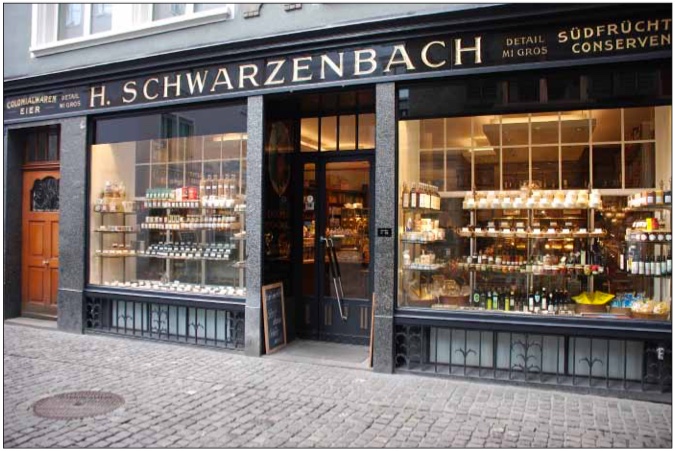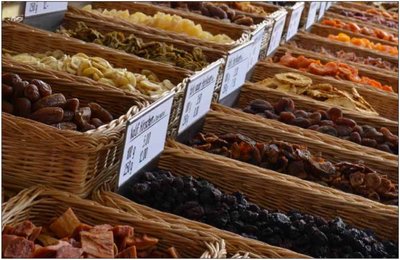Colonial goods – success against the mainstream
Colonial goods – success against the mainstream
Nostalgic grocery store with charm
by Heini Hofmann
Everyone is talking about corporate imaging, ranking, upgrading and being in. Restructuring and modernizing must take place everywhere come hell or hight water. One concept follows the other. Switzerland’s last colonial goods store, which has been successfully putting its money on nostalgia for over 150 years and now in its fifth generation, proves that there is another way.

In the fast food age, food degenerates into loveless, industrial mass goods. Hence the desire for more originality. The fact that such an experiment can be worthwhile is shown by the example of the Zurich family business Schwarzenbach, a curiosity and at the same time flourishing contemporary document. When you marvel at the countless exotic products in the old-fashioned shop windows and close your eyes for a moment, you think you’re seeing a camel caravan passing by, dark-skinned people working in the shade of palm trees, and all the scents of Arabia caress your nose. But the dream is reality.
In Zurich’s old town, to the right of the river Limmat, between Oberdorf and Niederdorf, less than a hundred metres from Grossmünster (Great Minster) and diagonally opposite the Cabaret Voltaire, not far from Gottfried Keller’s favourite pub or the house where Comrade Lenin spent the time before the Russian Revolution, in the middle of the history-laden old Zurich, there it is, this flourishing contemporary document.
Different from the others
This last colonial goods store in Switzerland may seem antiquated due to its awareness of tradition. But that’s deceptive, because the Schwarzenbachs outshine a lot in terms of company imaging and corporate identity. Where else in Switzerland is there a retail shop as a family business whose patron, in the fifth generation (!), bears the same first name, from Henry I to Henry V, which also retains its old company name (colonial goods), which explains the origin of the goods, and which still displays the original shop fittings and assortment as usual?
This consistent pursuit of a personal touch, which today almost enjoys cult status, is reflected in the Schwarzenbach colonial goods store in its individual identity as an authentic product of its own biography. Like a rock in the surf, this relic stands in the midst of the hectic pace of an accelerated economic world. Its window displays and shop fittings have hardly changed since it was founded. There is no riding on the wave of short-term success here, pursued by the compulsion of constant change and renewal. It is not about being in, but staying oneself, unlike the others.
Here, an independent corporate culture, which one might smile at as dusty, is courageously and consistently passed through generations in order to gain long-term added value in the sense of constancy and the resulting trust. A seemingly unreal, out-of-time recipe that seems to work perfectly thanks to its uniqueness and originality. The own path, even if it is stony, often proves to be more purposeful than the more comfortable mainstream in business life.
In the rear view mirror of history
Historically, colonialism (= economic expansion with political domination) is a strained term. Colonies were the mostly “overseas” possessions acquired by European states. Modern colonialism began parallel to the great discoveries in the 15th century and was a mix of trade interests, exploitation of raw materials, political interests and the urge to missionise – a chapter of history with a great shadow cast.
After decolonisation, economic and cultural relations between former colonies and their former – as it was so nicely called – “motherland” continued to exist to this day.
Small Switzerland has never owned any colonies. But at least indirectly it also took part in the process of European expansion, on the one hand by emigrating of various kinds (foreign military service, founding settlements, mission), on the other hand by foreign trade, i.e. industrial exports and by importing cheap colonial goods.
In the past, these somewhat exotic-looking colonial goods shops with their foreign assortment existed everywhere, both in the cities and in the countryside. In order to do justice to history and probably also to New German, this name gradually disappeared completely after the Second World War – with the exception of Schwarzenbach’s colonial goods shop in Zurich’s old town, which can already look back on over a century and a half.
A touch of 1001 nights
This magical institution is reminiscent of a grocery store from earlier times. The shop fittings, sales counter and wall racks date from the Gründerzeit period. Old lettering promote the products: Colonial goods, coffee roasting, tropical fruits and canned food. The note “Detail und Mi gros” refers to earlier house and hotel deliveries. The window displays are a sensual land of milk and honey from 1001 nights.
What began in 1864 with pasta, eggs, spices and coffee is today a huge assortment of around 3,000 items: 17 different coffee blends (the green coffee purchased by the customer single-handedly is roasted twice a week visible from the street) and no less than 150 types of tea. You can try both in the attached tea café and find out that tea and coffee, like wine or cheese, are regional products with their own character, shaped by climate, soil and processing.
Today, the shopping basket is enormously rich. The colourful range of dried fruits, berries, nuts and kernels in the open assortment is particularly impressive (see box). There is also a large selection of honey, jam, chocolate and candied fruit, salt, mustard and spice specialities, oil and vinegar, pulses, flour and flakes, rice and pasta. And of course everything without self-service, but with informative sales advice.
Advantages of the small business
In the past the exotic products came from the colonies; today people travel themselves and get to know foreign specialities, which they would like to have at home. This changes and increases the supply and adapts to demand.
Heini V. Schwarzenbach, the great-great grandson of the company founder and current company manager in the fifth generation, is visibly proud: “Because a small company is more agile, it can react more quickly to customer wishes. In general, in addition to the quality of the offer, proximity to the customer and his individual advice play a decisive role; because the feedback from the customers allows us to react immediately and correctly to the assortment sorting. As soon as newly introduced products have established themselves, they are often copied into their fine food lines by large distributors.”
The modern grocer emphasises this with obvious pride: “Direct contact with the producers is also decisive, and we spend a lot of time on this. We are always on the move with our eyes open and therefore know which products are the best. And we check them in advance and only buy fresh produce” Success over generations seems to prove him right. •
(Translation Current Concerns)
Range of dried fruit


HH. “They are not only healthy thanks to their concentrated nutrients, vitamins and trace elements; they also have an ecological advantage thanks to more environmentally friendly transport by sea and land instead of by air”, stresses one saleswoman.
From all corners of the world
Classics among the dried fruit are figs, such as the small wild ones from Iran or the thin-skinned Izmir figs. For the fruitless season dried figs have always been basic foodstuffs like bread. As fresh figs are very sensitive and can only be kept for a short time, dried figs are also better suited for transport and are even cheaper.
In addition there are also pitted dates from Tunisia or huge Medjool dates from California, banana chips from the Philippines, banana fingers from Costa Rica, pineapple from Thailand and Togo, mango slices from Mexico, papaya slices and coconut strips from Thailand, Australian ginger, jackfruit from Sri Lanka, kumquats (baby oranges) from the Philippines, nectarine halves from California, kiwi slices from Iran, jumbo apricots from California, “Kurpflaumen” (pitted dried prunes) from Chile and red sour cherries from Michigan.
Of course – despite the colonial concept – local products are not missing: sour-aromatic Fellenberger prunes, Swiss apple rings with the peel, apple slices with the peel as in grandmother’s times for “Schnitz und drunter” (an Aargau speciality) or “Gute Luise”-pears for casseroles or dried pear bread. Dried fruit can be eaten as they are or can be integrated into desserts or fruit salads.
Berries, grapes, nuts, seeds
Among the dried berries and grapes are Chilean strawberries, cranberries from Oregon, gooseberries from Colombia, barberry berries from Iran, Spanish malaga grapes (muscatel), raisins from Greece (currants) and sultanas from Turkey or extra large ones (flames) from Chile, the latter as a seedless alternative to malaga grapes.
There are also nuts in all variations: Grenoble walnuts, Chilean walnuts, hazelnuts from Italy, plus the extra large Roman giants, brown almonds from Spain and also white (ferranges) and aperitif salted almonds, Californian almond sticks (not to be missed in any bakery) and bitter almonds.
Moreover peanuts and wasabi-crusted peanuts, Bolivian Brazil nuts, Indian cashew kernels, Kenyan macadamia nuts, Californian aperitif pistachios and Portuguese pine nuts. Finally sunflower and pumpkin seeds from Austria, although here the colonial origin should be put into perspective again ...
(Translation Current Concerns)